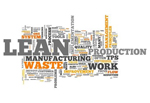01.15.2013
What’s This “Lean” Stuff All About?
 You can call it lean, elimination of waste, intelligent work methods, or whatever you’d like. While many people think lean is an option, in today’s world, if you don’t subscribe to the “lean way” of thinking and doing business, you cannot be competitive.
You can call it lean, elimination of waste, intelligent work methods, or whatever you’d like. While many people think lean is an option, in today’s world, if you don’t subscribe to the “lean way” of thinking and doing business, you cannot be competitive.
Those in manufacturing and construction have spent years concentrating on efficiency, or on how fast people work, as a means to increase productivity. Those in manufacturing focused on increasing speeds and feeds of machinery, while those in construction looked at new tools to speed the process. In both cases, moderate improvements were made in productivity. What was ignored, were all of the activities surrounding the work efforts that contributed to wasted time or detracted from improved productivity.
So how is lean involved? Lean is all about eliminating waste. It does not focus on people and how fast they work (efficiency), it focuses on processes and how to maximize the amount of time spent doing the work (utilization). Certainly efficiency and best practices are important ingredients to productivity improvement; however, utilization is more critical, and has many more opportunities for improvement.
Having trust and faith in people is one of the most important elements of lean. What used to be a “park your brains at the door” attitude, has thankfully become a participative “we need your knowledge, experience, and input” approach. Who knows better what needs to be done to improve productivity – those who sit in an office somewhere distant from the work environment, or those out on jobsites performing the work? Lean pushes decision making to the lowest level possible. This means equipping those who do the work with all of the information required to perform the work well.
Another important element of lean is leadership. People need to have leaders who coach and share information, not who tell people what to do and believe answers lie with individuals versus teams.
We now know if you get the tools, information, and materials into the hands of those who are charged with performing work – that work gets done. So focus on providing these items to those in charge, encourage their participation in making decisions, and get out of the way. Look at leadership as working “for” the team focused on doing everything possible to remove obstacles, and efficiently get the team what they need to get the job done productively. In my next blog article, I’ll focus on Faith Technologies’ techniques and commitment to this lean journey.
If you enjoyed this blog article, please subscribe to stay up to date on the latest industry news from our experts at Faith Technologies.



